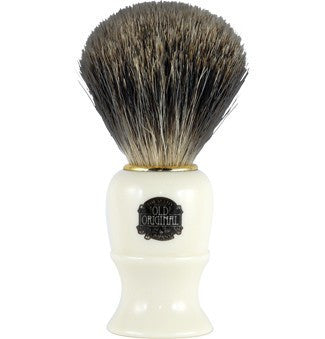It can be very difficult for a beginner to wet shaving to understand why they should spend so much money on a brush. This Buyer's Guide explains the difference between all the difference shaving brushes available
A common question we get asked is 'Why should I use a shaving brush?' which is quickly followed by 'What is the difference between Synthetic, Boar, and Badger bristles?'
There are many different types of brushes which all have the following different properties - bristle thickness and stiffness, moisture-holding capacity, price, and the ability to generate and apply a soap lather.
Shaving Brush Anatomy
Before we dive in, let's define our terms. Shaving brushes have special names for their different components including:
- The bristles
- The handle
- The knot

A shaving brush has a few key specifications that you should be aware of:
- The bristle grade - this defines what the bristles are made of as well as how soft they are and the amount of moisture they can hold
- The handle material - this is important both for the weight of the brush and its aesthetic appearance
- The knot diameter - this is a measure of the width of the bristles where it is attached to the brush and is used to define the size of the brush
- The loft - this is the height of the bristles and helps to define the height of the brush
Badger Hair Shaving Brushes
Badger brushes are the gold standard of brushes and have a softer bristle pattern which holds more water, creates a better lather and is generally more luxurious. There are several different quality types of badger brushes with a large range in price.
Badger brushes can be split up into further categories:
- Pure - pure badger hair is the most common and abundant source of badger hair. It is on the stiffest side which can be good for trying to lather very hard soap pucks.
- Best - best badger hair is sourced from the belly of the badger and is softer than pure badger hair. It can also store more water so is ideal for dense shaving creams.
- Super - super badger hair is extremely soft but is not as easily available. This gives it superior water-absorbing capacity but can be more difficult to maintain with the fine, delicate bristles.
- Silvertip - this is the rarest and most expensive category of badger hair. It is sourced from the same area as super badger hair but is sorted very carefully based on softness and colour. It is the gentlest and most delicate but can often cost more than $1000 per brush.
Synthetic Shaving Brushes
Boar Bristle Shaving Brushes
Boar brushes are generally the cheapest type and have thick, stiff bristles. They hold less water than badger brushes and create a lower quality lather, but as mentioned before have a lower price.
We don't sell boar shaving brushes at Cut Throat Club due to the lower quality. They are simply not up to the standard of quality that we hold ourselves to.
Horse Hair Shaving Brushes
There are also horse hair brushes available, however, these are much less common. They are generally only used if you have an allergic reaction to the other brush types.
You should consider your requirements around quality, bristle stiffness and price before making a decision.
Quick Tip
Always store your shaving brush upside down with the bristles facing down. This allows the moisture to drain out of the brush completely and leave it dryer once the brush has been cleaned. If you store your brush upright then the moisture will get stuck in the knot which can damage the adhesive over time and cause the bristles to begin falling out.
Frequently Asked Questions
Should you use a shaving brush with a straight razor?
Absolutely - the best way to get a smoother shave is to provide lubrication between the blade and your skin. This can be done by shaving creams, gels, or foams. The thickest lather is achieved using a shaving soap that has been lathered into a thick foam using a shaving brush.
We recommend using a shaving brush with a quality soap when using a straight razor for the best results.
How long do shaving brushes last?
Shaving brushes will last from 10 - 15 years. Over time you will lose some individual bristles and the adhesive will degrade. You can maintain older shaving brushes so that they last for generations, but this requires good storage practices.
How to store a shaving brush?
Always store your shaving brush upside down with the bristles facing down. This will drain all excess moisture and make sure that the adhesive in the knot lasts as long as possible.
Do new shaving brushes stop shedding?
Yes, new shaving brushes stop shedding after around 10 shaves. This occurs when some individual bristles have not been attached securely by the adhesive in the brush knot. Over time these individual bristles will fall out and you will be left with securely attached bristles.
Conclusion
That brings us to the end of this article. Hopefully, we have been able to give you some insight into the differences between shaving brushes and helped you to make a better buying decision.
See our range of badger haired shaving brushes here to see the difference for yourself.
If you have any concerns or questions about shaving brushes then please leave a comment below. We love to hear from our customers and hope that everyone can learn from the discussion.


Conclusion - Phew!
That is everything. If you are interested in shopping with us then check out the Cut Throat Club's product range.
We would love to get your input on any differences of opinion you have or other lessons you have learned that our readers would value - Please leave a comment below.